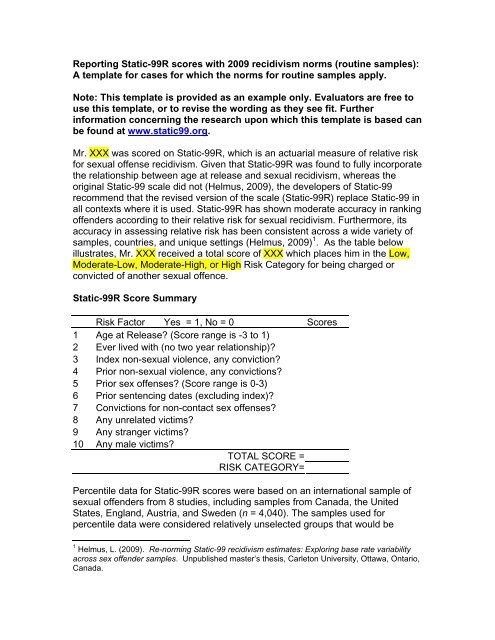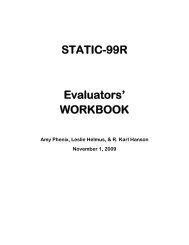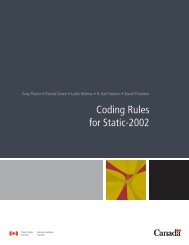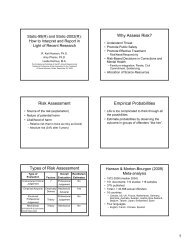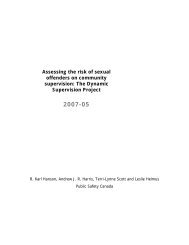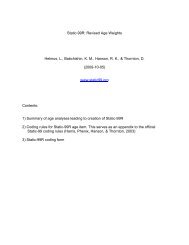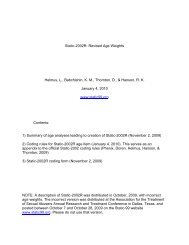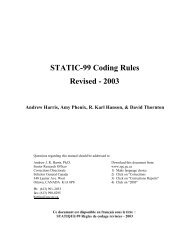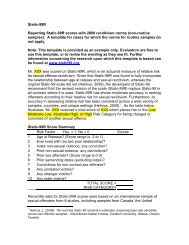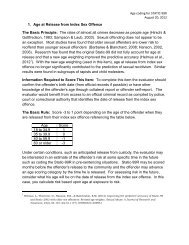routine samples - Static-99
routine samples - Static-99
routine samples - Static-99
You also want an ePaper? Increase the reach of your titles
YUMPU automatically turns print PDFs into web optimized ePapers that Google loves.
Reporting <strong>Static</strong>-<strong>99</strong>R scores with 2009 recidivism norms (<strong>routine</strong> <strong>samples</strong>):<br />
A template for cases for which the norms for <strong>routine</strong> <strong>samples</strong> apply.<br />
Note: This template is provided as an example only. Evaluators are free to<br />
use this template, or to revise the wording as they see fit. Further<br />
information concerning the research upon which this template is based can<br />
be found at www.static<strong>99</strong>.org.<br />
Mr. XXX was scored on <strong>Static</strong>-<strong>99</strong>R, which is an actuarial measure of relative risk<br />
for sexual offense recidivism. Given that <strong>Static</strong>-<strong>99</strong>R was found to fully incorporate<br />
the relationship between age at release and sexual recidivism, whereas the<br />
original <strong>Static</strong>-<strong>99</strong> scale did not (Helmus, 2009), the developers of <strong>Static</strong>-<strong>99</strong><br />
recommend that the revised version of the scale (<strong>Static</strong>-<strong>99</strong>R) replace <strong>Static</strong>-<strong>99</strong> in<br />
all contexts where it is used. <strong>Static</strong>-<strong>99</strong>R has shown moderate accuracy in ranking<br />
offenders according to their relative risk for sexual recidivism. Furthermore, its<br />
accuracy in assessing relative risk has been consistent across a wide variety of<br />
<strong>samples</strong>, countries, and unique settings (Helmus, 2009) 1 . As the table below<br />
illustrates, Mr. XXX received a total score of XXX which places him in the Low,<br />
Moderate-Low, Moderate-High, or High Risk Category for being charged or<br />
convicted of another sexual offence.<br />
<strong>Static</strong>-<strong>99</strong>R Score Summary<br />
Risk Factor Yes = 1, No = 0 Scores<br />
1 Age at Release? (Score range is -3 to 1)<br />
2 Ever lived with (no two year relationship)?<br />
3 Index non-sexual violence, any conviction?<br />
4 Prior non-sexual violence, any convictions?<br />
5 Prior sex offenses? (Score range is 0-3)<br />
6 Prior sentencing dates (excluding index)?<br />
7 Convictions for non-contact sex offenses?<br />
8 Any unrelated victims?<br />
9 Any stranger victims?<br />
10 Any male victims?<br />
TOTAL SCORE =<br />
RISK CATEGORY=<br />
Percentile data for <strong>Static</strong>-<strong>99</strong>R scores were based on an international sample of<br />
sexual offenders from 8 studies, including <strong>samples</strong> from Canada, the United<br />
States, England, Austria, and Sweden (n = 4,040). The <strong>samples</strong> used for<br />
percentile data were considered relatively unselected groups that would be<br />
1 Helmus, L. (2009). Re-norming <strong>Static</strong>-<strong>99</strong> recidivism estimates: Exploring base rate variability<br />
across sex offender <strong>samples</strong>. Unpublished master’s thesis, Carleton University, Ottawa, Ontario,<br />
Canada.
epresentative of the population of all adjudicated sex offenders within a given<br />
correctional system. The norms are presented as percentile ranges, reflecting the<br />
observed percentage of offenders scoring at or below a specified score.<br />
Percentile rankings are useful in situations where the allocation of limited<br />
resources must be made, such as for treatment, community supervision, etc.<br />
Absolute degrees of recidivism risk cannot be directly inferred from the percentile<br />
rankings. The appropriateness of applying these percentiles to sexual offenders<br />
in jurisdictions other than those listed above is not known.<br />
Compared to a representative and international sample of adult male sexual<br />
offenders, Mr. XXXX’s <strong>Static</strong>-<strong>99</strong>R score of xxx falls into the xxxx to xxxxx<br />
percentile. This percentile range means that cc-dd percent of sex offenders in<br />
these <strong>samples</strong> scored at or below Mr. XXXX’s score. Conversely, ee-ff percent<br />
of this sample of sex offenders scored higher.<br />
Relative risk refers to the ratio of two recidivism rates. Research has found the<br />
relative risk associated with different <strong>Static</strong>-<strong>99</strong>R scores to be consistent even<br />
when the overall base rate of recidivism varies across <strong>samples</strong>. Information<br />
concerning relative risk for <strong>Static</strong>-<strong>99</strong>R scores were based on 22 <strong>samples</strong> of<br />
sexual offenders from Canada, the United States, the United Kingdom, Denmark,<br />
Holland, Austria, Sweden, Germany, and New Zealand (n = 8,047).The<br />
recidivism rate for sex offenders with the same score as Mr. XXXX would be<br />
expected to be approximately (half/two thirds) of (FOR SCORES LOWER THAN<br />
2), the same as (FOR SCORES OF 2), X.X times higher than (FOR SCORES<br />
GREATER THAN 2) the recidivism rate of the typical sexual offender (defined as<br />
median score of 2).<br />
There have been a large number of studies examining the absolute sexual<br />
recidivism rates associated with <strong>Static</strong>-<strong>99</strong> scores. Helmus (2009) combined 28<br />
<strong>Static</strong>-<strong>99</strong> replication studies and was able to calculate <strong>Static</strong>-<strong>99</strong>R scores for 23 of<br />
these <strong>samples</strong>. The <strong>samples</strong> (n = 8,139) were drawn from Canada, the United<br />
States, United Kingdom, western Europe and New Zealand. Recidivism was<br />
defined as charges in about half of these studies and as convictions in the other<br />
half.<br />
Although the relative risk was consistent across studies, the observed recidivism<br />
base rates varied considerably across <strong>samples</strong> based on factors not measured<br />
by <strong>Static</strong>-<strong>99</strong>R. Samples that were preselected to be high-risk/high needs (6<br />
<strong>samples</strong>) show the highest recidivism rates, <strong>samples</strong> preselected based on<br />
treatment need (6 <strong>samples</strong>) had intermediate recidivism rates, and <strong>routine</strong><br />
correctional <strong>samples</strong> had recidivism rates substantially lower than the<br />
preselected groups (and also lower than the recidivism rates in the original<br />
development <strong>samples</strong> for <strong>Static</strong>-<strong>99</strong>).<br />
In applying the recidivism norms it is ideal to use local norms that are applicable<br />
to the group of offenders to which this offender most closely resembles. Given
that these norms are not often available, the <strong>routine</strong> sample will usually reflect<br />
the most appropriate recidivism rates as they are representative of typical sex<br />
offenders in correctional systems. A description of the <strong>routine</strong> correctional<br />
<strong>samples</strong> follows:<br />
Routine Correctional Samples<br />
This group consisted of eight <strong>samples</strong> of sex offenders from Canada, the United<br />
States, England, Austria and Sweden. These <strong>samples</strong> were relatively random<br />
(i.e., unselected) <strong>samples</strong> from a correctional system (as opposed to <strong>samples</strong><br />
from specific institutions or subject to specific measures). In other words, they<br />
can be considered roughly representative of all adjudicated sex offenders. Some<br />
offenders in these <strong>samples</strong> would have been subsequently screened for<br />
treatment or other special measures (e.g., psychiatric admission or exceptional<br />
measures related to dangerousness), but these <strong>samples</strong> represent the full<br />
population of all offenders prior to any preselection processes. The recidivism<br />
norms for the unselected <strong>samples</strong> are the closest available to a hypothetical<br />
average of all sex offenders.<br />
Mr. XXXX scored a XX on the <strong>Static</strong>-<strong>99</strong>R. Offenders from <strong>routine</strong> correctional<br />
<strong>samples</strong> with the same score as Mr. XXXX have been found to sexually reoffend<br />
at a rate of XXXX percent in five years.


